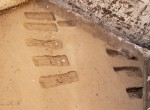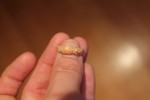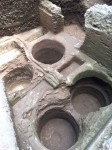 Archaeologists have unearthed a medieval Jewish cemetery in the Trastevere neighborhood of Rome. The discovery was announced last week, but it was made over the course of six years of excavations done in conjunction with the restoration of the Palazzo Leonori, now the new headquarters of the Assicurazioni di Roma insurance company. It was under the palazzo’s courtyard that 38 graves were found, neatly aligned in rows. Iron nails and wood fragments indicate the bodies were buried in coffins, now long-decayed.
Archaeologists have unearthed a medieval Jewish cemetery in the Trastevere neighborhood of Rome. The discovery was announced last week, but it was made over the course of six years of excavations done in conjunction with the restoration of the Palazzo Leonori, now the new headquarters of the Assicurazioni di Roma insurance company. It was under the palazzo’s courtyard that 38 graves were found, neatly aligned in rows. Iron nails and wood fragments indicate the bodies were buried in coffins, now long-decayed.
Each grave contained a well-preserved, intact, articulated skeleton. The remains are of adult men and women, mostly men, and contain almost no grave goods. The only exceptions were two of the women, found wearing small gold rings, and one man who was buried with a set of iron scales, perhaps an indication of his profession or a metaphoric representation of a just man. Examination of the bones found signs of malnutrition and protein deficiencies. These were not wealthy people.
 Because there were no grave markers discovered and with the excavation area limited by later construction, at first archaeologists weren’t sure whose bodies they’d found. They searched archives for maps and documents that might shed light on the question, and the find spot was marked on several maps as the Campus Iudeorum, or Field of the Jews, the cemetery of the Jewish community that lived in Trastevere from the mid-14th century through the mid-16th. Radiocarbon dating of the remains returned dates within that range. The lack of grave goods is also characteristic of Jewish burials. The last piece of the puzzle fell into place when a marble fragment inscribed in Hebrew with the words “here lies” was discovered nearby.
Because there were no grave markers discovered and with the excavation area limited by later construction, at first archaeologists weren’t sure whose bodies they’d found. They searched archives for maps and documents that might shed light on the question, and the find spot was marked on several maps as the Campus Iudeorum, or Field of the Jews, the cemetery of the Jewish community that lived in Trastevere from the mid-14th century through the mid-16th. Radiocarbon dating of the remains returned dates within that range. The lack of grave goods is also characteristic of Jewish burials. The last piece of the puzzle fell into place when a marble fragment inscribed in Hebrew with the words “here lies” was discovered nearby.
Jews have lived in Rome since the Maccabees sent a delegation in the 2nd century B.C., and by the Middle Ages the Trastevere area, with its bustling Tiber-side commerce and diverse population, was one of Rome’s main Jewish quarters. That ended abruptly in 1555, when all the Jews in Rome were ordered to pay for the privilege of being forced into the waterless, claustrophobic, flood-prone, malarial ghetto by the virulently anti-semitic Pope Paul IV. His Papal Bull, Cum nimis absurdum, decreeing their confinement to the ghetto and many other hateful provisions, minces no words. It opens:
Since it is completely senseless and inappropriate to be in a situation where Christian piety allows the Jews (whose guilt-all of their own doing-has condemned them to eternal slavery) access to our society and even to live among us; indeed, they are without gratitude to Christians, as, instead of thanks for gracious treatment, they return invective, and among themselves, instead of the slavery, which they deserve, they manage to claim superiority….
 So the living Jews who stayed in Rome after 1555 moved across the river into the ghetto hellhole. Their deceased ancestors remained in place. It was not to be a peaceful sleep of death, alas. In 1625, our Barberini friend Pope Urban VIII found the time between tapestry appreciation, adding bees to everything and stripping ancient bronze off the Pantheon to decree that all Jews in Rome must be buried in unmarked graves. No names of Jews were to be carved in stone, period. (Exceptions were occasionally made for very prominent rabbis or wealthy men.) Extant gravestones were to be destroyed. Then in 1645, the cemetery was built over when a new city wall was constructed. This is why only a single fragment of a headstone was found in the excavation.
So the living Jews who stayed in Rome after 1555 moved across the river into the ghetto hellhole. Their deceased ancestors remained in place. It was not to be a peaceful sleep of death, alas. In 1625, our Barberini friend Pope Urban VIII found the time between tapestry appreciation, adding bees to everything and stripping ancient bronze off the Pantheon to decree that all Jews in Rome must be buried in unmarked graves. No names of Jews were to be carved in stone, period. (Exceptions were occasionally made for very prominent rabbis or wealthy men.) Extant gravestones were to be destroyed. Then in 1645, the cemetery was built over when a new city wall was constructed. This is why only a single fragment of a headstone was found in the excavation.
The Jews were allowed to move what remains they could to a new cemetery on the Aventine, but struggle followed them. Giambattista Nolli’s 1748 map of Rome marks the spot as the “Ortaccio degli Ebrei,” meaning “Garden of the Jews,” although that doesn’t convey the pejorative connotation of the suffix -accio. (The Ortaccio was the name for 16th century Rome’s red light district where the prostitutes were walled in much like Jews were in the ghetto.) Interestingly, Nolli’s map also shows how the Jews were forced to move across the river to the Aventine and may have been bumped one more time after that. The Trastevere cemetery site is on the left side of the map outlined in green. On the right side outlined in red is another “Ortaccio degli Ebrei,” presumably the active one in Nolli’s time, directly overlooking the Circus Maximus, which was itself divided into farmland. Just a hop to the southwest outlined in blue is the “Ortaccio Vecchio degli Ebrei,” or the “Old Garden of the Jews.” If that was the old one, the other one must have been (relatively) new.

The Aventine cemetery had an even shorter life than the Trastevere one. It was destroyed in 1934, this time courtesy of Mussolini’s grandiose plan to redesign Rome to showcase its ancient glories. Workers dug up all of the graves, put the bones in boxes and moved them to the Campo Verano cemetery outside the Roman walls where they were reburied in the Jewish section. The last Garden of the Jews is now a rose garden. Today only a modest memorial records what had once been a field of white gravestones with generations of Roman Jews buried beneath them.
 The Palazzo Leonori site will become a mini-museum where some of the discoveries made in the six years of excavation will be on display. Large plastered tubs identified by an inscription as part of the Coraria Septimiana, 3rd century A.D. tanneries built by the emperor Septimius Severus to tan leather products for exclusive supply to the Roman army, will be viewable to the public in the courtyard of Palazzo Leonardi, a sort of mini-archaeological park.
The Palazzo Leonori site will become a mini-museum where some of the discoveries made in the six years of excavation will be on display. Large plastered tubs identified by an inscription as part of the Coraria Septimiana, 3rd century A.D. tanneries built by the emperor Septimius Severus to tan leather products for exclusive supply to the Roman army, will be viewable to the public in the courtyard of Palazzo Leonardi, a sort of mini-archaeological park.
The human remains will not be part of any future such plans, nor will they be studied further out of respect for the dead. Presumably they will be reinterred, but no decision has been announced at this time. The archaeological team is working closely with rabbinical authorities, among them Rome’s Chief Rabbi Riccardo Di Segni, to determine the next steps.
Accounts of archaeology are all about the finds. By contrast I enjoyed this light newspaper article about what goes on before a find of any consequence is made; maybe none such will be made.
http://www.cambridge-news.co.uk/news/cambridge-news/9-amazing-things-revealed-workers-12816376
Interesting that they were buried in coffins.As far as I know back then they were not buried in coffins, even today Orthodox Jews (where it is allowed by law)and Israelis are not buried in coffins.
In OpenStreetmap (at 12° 28′ 17,7″E, 41° 53′ 01,0″N), there seems to be a disdained car park (‘Parking Trastevere’).
‘Non-car’ parks and rose gardens, i.e. in our case the Roseto di Roma Capitale (‘Rome Rose Garden’), on former inner-city graveyards are actually quite common. In some European cities people do even walk on former tombstones, which I personally like much more than having car parks.
PS: Whatever you do, do rest in peace
As a latecomer, I’m still working my way through your archival treasure trove. It’s addictive and has caused many a late night (I’ll just read one more article…).
Back on topic, that gold ring looked vaguely familiar: is the central motif a hand? I have a similar ring, albeit with two clasped hands. So it was off down the rabbit hole, where I learned that hands are a symbol common to not only Jewish wedding rings but also Western rings pledging fidelity (mani in fede), in use from Roman times to the present day.